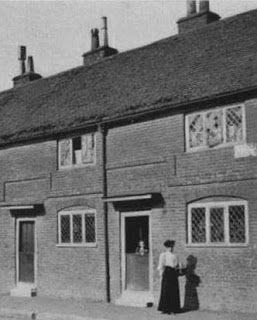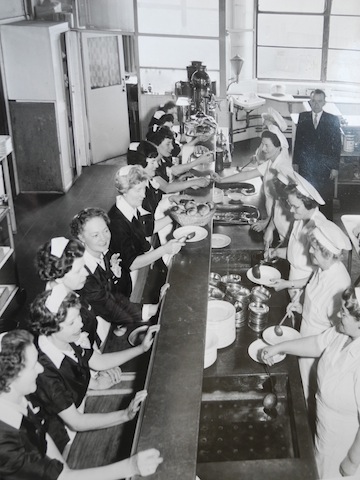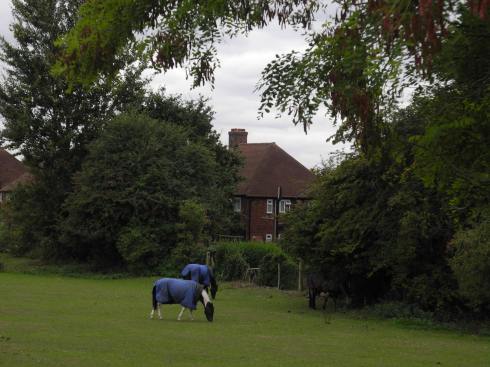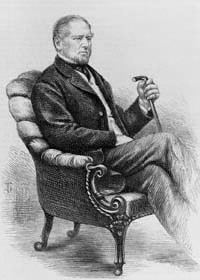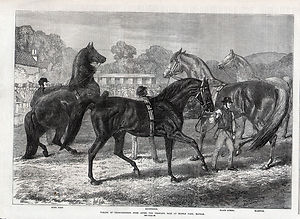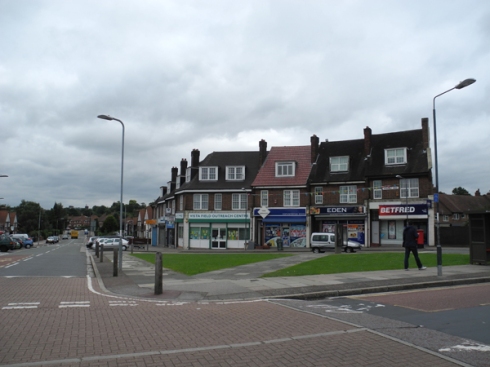You are currently browsing the category archive for the ‘Uncategorized’ category.
Over the last decade or so property developers have become the dominant force in shaping the Capital. It wasn’t always like that; in the past many of the buildings that define the city were built by philanthropists. Explore most areas in London and you can still see the almshouses, social housing, schools and libraries built for the good of the wider community.
I went on such an exploration of my local High Street. Philipot Path, an ancient right of way, runs parallel and behind Eltham High Street. Wedged between Sainsbury’s car park and Philipot Path are the Thomas Philipot Almshouses. They are obscured from the path by a six foot wall and are not visible from the car park. Stand on your tip toes you just might see some elegant chimney pots. The entrance to the almshouses is difficult to find, it took me two attempts. Hemmed in by the car park, hard surfaces and the detritus of the High Street shops are an elegant and grand set of buildings which are hidden in plain sight.
Thomas Philipot was a local landowner who bequeathed funding for six almshouses for poor people living in the parishes of Eltham and Chislehurst. Originally, the almshouses were on the High Street and were built 1694 where they remained until 1926.
Woolwich Borough Council purchased the almshouses in order to widen the High Street. They were rebuilt on the current site in 1931. When they were built they backed on to the convent school run by the Sisters of Mercy (now Sainsbury’s car park). Sainsbury’s bought the site in the 1960s and a new secondary school, St Thomas More opened 1964 close by.
The original convent can still be seen on the High Street a large imposing white building now St Mary’s Community Centre. The first Convent of Mercy in England was opened in Bermondsey in 1839 by Mary Catherine McAuley who founded the order. She had inherited a considerable fortune and chose to use it to build a house where she and other compassionate women could take in homeless women and children to provide care and an education for them. The Eltham convent was a branch house of Bermondsey and it was opened in 1874. In 1946 they opened an Approved School close by in Glenure Road, now St Mary’s Primary School. An Approved School was a residential institution to which young people could be sent by a court for committing offences or sometimes because they were beyond parental control.
Now the area is dominated by Sainsburys but its worth taking a closer look and discovering these gems left as a legacy to a philanthropic past.
** Image from http://chorltonhistory.blogspot.co.uk/2014/12/making-claim-to-elthams-history.html
From Wandsworth to Woolwich the south bank of the Thames is being transformed with ubiquitous luxury apartments now rising from former industrial sites. Trapped between the tower blocks and the cranes you can still find places and buildings that remind you that even thirty years ago South London was unfashionable. Go back even further to Victorian London and this was a place for the very poor. Much of the work available on the docks was casual and low paid. Housing conditions were very poor with considerable overcrowding. Victorian philanthropists and social commentators were drawn to the area to develop schools and missions.
A short walk from London Bridge you can still find the remnants of one of London’s poorest districts. Redcross Way is just off Southwark Street accessed through one of the railway arches. On the left there is an iron gateway covered in brightly coloured ribbon, feathers and flowers and behind this is a once forgotten grave yard for the out casts of society or Cross Bones. The bodies of 15,000 paupers and prostitutes have been buried in this unconsecrated ground since medieval times. Vigil candles are placed around the gates and help to reflect on lives ruined by poverty. It was widely believed, in Victorian times, that a cure for syphillis was to have sex with a virgin and some of the prostitutes buried here are young girls victim of this practice. Vigils for the outcasts of society are held every month more details here.
Across the street is The Mint and Gospel Lighthouse Mission; a mouthful for most people so no wonder it became known as The Ragged School. The Ragged School Union was formed by the 7th Earl of Shaftesbury 1844. They developed small free schools in deprived areas providing basic education and skills to destitute children. Often the schools tried to meet other community needs such as reading clubs, adult literacy classes, clothing clubs and Penny Banks.
St Saviour’s House is also in Union Street and is a striking building. It is still home to a charity that dates back to the C15th and have been providing support to the people of Southwark.
Redcross Garden is a little further on which was developed by the Octavia Hill 1887. It was to provide small scale social housing and a communal garden. The garden was restored in 2005 and includes a small pond and a new eco-building. In the central pavillion there is an inscription:
“Do noble deeds do not dream them”.
The row of six Redcross cottages were built for the working poor. The White Cross cottages were a later addition 1890 and can be accessed through a small alley. Now overshadowed by The Shard, an ever present symbol, that this is a place for the super rich.
Dickens visited Greenhithe when compiling his 1880 Dictionary of the Thames and had this to say:
“Except as a yachting station Greenhithe itself offers but little to notice.”
Just east of the Dartford Crossing it’s better known today for its proximity to Bluewater shopping centre and Ebbsfleet International station. In my view, there is now something distinctive about the place; for it’s one of the few low rise developments along the banks of the Thames.
Built around the remnants of the High Street, which has period properties dating back to 1768, the new development blends in well.
It’s good quality housing that’s been designed to complement the landscape and heritage of the area. You get a distinct sense of community. There are riverside playgrounds which reinforces that this is a sustainable community, where people live, use schools and other local services and pay taxes. Prices are considerably lower than riverside properties further upstream. It’s been awarded a gold standard by Cabe.
The estate takes its name from Ingress Abbey a large mansion built facing the river for a local alderman. It was built in part by stones from the Old London Bridge.
A road sweeps down to the restored Ingress Abbey in the centre of the estate, surrounded by its grass amphitheatre. A car-free avenue leads to the Thames.
There are two pubs on the High Street, the John Franklin and The Pier. At low tide the rotting carcass of a boat can be seen close to the John Franklin, it looks as though its been there for many years. The landlord explained that a Dutch couple had some engine difficulties and left it there 30 years ago never to return. The London Port Authority assessed it as not a danger to shipping and so it has remained.
The riverside pathway takes you past the Pier Hotel which had a jetty erected around about 1880 which can still be seen and is now a resting place for basking sea gulls. There is also the marker for the berthing place of HMS Worcester which from1862 was the Thames Marine Officer Training School. In 1938 the college acquired the Cutty Sark and it remained here until 1954 when it moved to Greenwich.
Local estate agents boast of a 45 minute train journey to London Bridge. Progress seems to have faltered, back in 1880 Dickens writes about the express train into Charing Cross taking 45 minutes.
The curious visitor to Stamford may wonder how this town avoided the sprawl and squalor of the industrial period. Preserved in aspic it’s the perfect location for a Jane Austin drama.
Situated close to the Great North Road the town was a natural stopping point for coaches traveling between London and York. Today you can still see the great coaching inns like the George with its iconic sign which crosses the street and the Crown in Red Lion Square. Each have repurposed their old stable blocks to meet very different client groups. Football fans who like a fag can enjoy the large outdoor screen at The Crown whilst shoppers with an eye for luxury goods can visit the boutique shops at the back of The George.
The town dates back to the C5th, situated on a hill above meadows rising from the River Welland. The river remains an unspoilt focal point with dramatic views at dusk. The town’s development was restricted by the open field system. What held development back more than anything was the Lammas Pasture rights – the right of the burgess to graze their cattle and sheep over the open fields after the harvest had been taken in. The fields could be in private ownership but the burgess still had the right of Lammas over any man’s land. Towns in the midlands were particularly affected by the system. By C19th the population and risen and the town needed to expand. It was a problem and one that the local aristocracy, down the road in Burghley House, wasn’t going to lend a hand in solving.
The town returned two MPs and only householders had the franchise. The Cecils owned 200 houses in the town so had a huge influence which they weren’t going to relinquish by allowing open fields to be enclosed and possibly developed. Fearful of Chartists they also ensured that the town didn’t get caught up in industrialisation. In 1846 there was a good chance that the London to York railway could pass through.
People of Stamford were anxious to get the trade because of the decline in the coaching trade. Lord Exeter (one of the Cecils) successfully prevented the railway coming and it went through Peterborough instead. Stamford’s development was choked off and it fossilised into the stunning Georgian town we see today. Good for today’s tourists but not for those living there at the time as from 1850 the population started to decline.
Today the town is still overshadowed by Burghley House and the public school situated in the heart of the town. Market day on Friday is a lively affair with vendors chanting to sell their fresh produce. The townsfolks’ spiritual and social needs are well catered for as there are several churches and numerous public houses. Sadly, not many of the pubs have survived as traditional boozers but have been modernised into restaurants or late night drinking holes with bouncers.
I know this has little to do with the Thames but it’s good for a visit.
In 1999 the RACs department store featured in a television movie The Greatest Store in the World. Up until the 1980s it certainly would have been the greatest store in South East London but in 1999 it was closed with no future prospects.
Membership of the RAC had been steadily increasing since its formation in 1868 and at the outbreak of the Second World War 1939 it was 382,000. In 1937 they planned a second large emporium in Woolwich. It was opened in stages 1939 and 1940 but it was not brought into full use until after the war. The streamlined building with horizontal lines and faience tiles makes an interesting architectural contrast to its sibling across the street.
Throughout the 1960s membership of the RACs increased. This transformative period saw a major re-fit of the store to make it up-to-the minute and reflect changing cultural values. On the third floor was a large bar and restaurant area plus a roof terrace
A travel bureau was a new feature reflecting the increased accessibility of foreign travel.
By the 1970s the membership of RACs reached half million but from this highpoint they began to suffer from the competition from the supermarkets. It was forced to merge with the Co-operative Wholesale Society in 1985. They used the upper floors as regional offices up until 1999 when it finally closed. In 2006 it was again used as a film set, this time for the dystopian science fiction film Children of Men. The abandoned store helping to conjure up an urban landscape of despair. After a period of uncertainty and threat of demolition there are plans to convert this important historic building into new residential accommodation.
Guest Post by BK
The Middle Park Stakes is run on October 12 this year on the famous Rowley Mile at Newmarket; where it has been held nearly every year since 1866. It is one of the most important races for 2-year old horses in the racing calendar and provides an important test for the following year’s prospective 200-Guineas and Derby entrants. Few people now realise that it shares its heritage with an estate in Eltham, perhaps most famous as the home of Boy George.
From the 16th to the 19th century Eltham was mainly farm and park land dominated by Eltham Palace. Originally the Palace estate was divided into 3; The Great Park; The Little, or Middle, Park; and Home, or Lee, Park. They were mainly wooded areas which provided land for deer-hunting. During the Commonwealth Cromwell’s troops killed the deer; and the trees were pulled down for shipbuilding. A survey of 1649 of Cromwell’s estates reported ‘The Middle Park, 333 acres 2 rods 7 perches. The deer and park all destroyed, and the park disparked by the soldiery and common people since the summer before. The trees marked for The Navy 1,000. The rest old and fit for fire. 334 worth £162.’ With The Restoration, Charles II gave the estates to his financier, Sir John Shaw, who built a grand house called Eltham Lodge, the Palace having fallen into disrepair. Great Park is now Royal Blackheath Golf Club and the Lodge is the clubhouse.
Middle Park served as a farm providing food for residents of The Great Park until it was sold in 1852. William Blenkiron was a Yorkshireman who was a successful business agent and manufacturer of socks and collars; but his main interest was breeding thoroughbred horses. He bought his first in 1847 and became so successful that he expanded by moving to Middle Park.
His success continued. In 1856, his first sale had 14 lots; by 1866, the year he endowed the race named after his farm; he gave a prize of 1,001 guineas, presumably to go one better than the classic race that is also run over the Rowley Mile; he had to expand to two sales per year. The sale had 58 lots and was worth £17,905 guineas. The sales were attended by nobility from Britain and even Europe.
Middle Park was by now the largest and most successful stud in the world and considered to be one of the biggest attractions in the country. Middle Park under William Blenkiron produced four Derby winners amongst a host of other classic victories. In 1867 his horse Hermit won in a snowstorm, beating Marksman which was another Middle Park product. The success was due to Blenkiron’s new theories and interest in horse breeding and the inheritance of genetic characteristics. He even corresponded on these matters with non-other than Charles Darwin who lived nearby at Downe House in Bromley.
He died at Middle Park on 25 September 1871 and he is buried in Eltham churchyard. His son then sold the stud in 1872 for 124,620 guineas. The land gradually reverted to agriculture until it was bought by Woolwich Corporation in 1931 to build housing.
Thus came to an end Eltham’s brief interlude as the world centre for horse-breeding. All that is left is the memorial in Eltham church yard and the shopping mall in the centre of Middle Park called Newmarket Green. At least they could have named a street after him.
My exploration of ancient markets along the Thames took me to Dartford and what a pleasant surprise that was. The walk from the station is a bit daunting as the road lay-out is designed for cars rather than pedestrians. I visited on a bright sunny Saturday and the market was vibrant and busy. Situated on the High Street it offers both shops and market stalls.
Dartford is an old market town and its charter dates back to James ll. The Royal Victoria and Bull Hotel dates back to 1703 and it is still a pub with accommodation. There is a space further down the High Street where the Le Bell public house stood which dated back to 1507 but was sadly demolished in 1962. An information board here titled One Town that Changed the World cites interesting facts such as Dartford was the first town to use gas lights.
The market stalls extend the full length of the High Street and sell clothes, plants, bags, housewares, fruit and veg. The range of local produce was impressive and the Kent new potatoes I bought was the best I’ve tasted in a long time. Richardson and Son butchers provides an impressive range of locally sourced meat. A French couple was in the queue before me and pleased with the excellent local produce I’d bought; momentarily I thought I was in France.
The town received a lot of publicity when it came to light that they had spent some of their £79,000 of Government cash to revive the High Street on a Peppa Pig character. Now, and then you will see a stall in a blue tent. One of the stallholders explained that these are the Portas’ bursary stalls. He had been a stallholder for over 40 years and was less than complementary about the Portas’ scheme claiming it was gimmicky and not sustainable. His view was that it should have addressed the fundamental problems of parking and business rates. Some of the new stalls were offering different things such as Mexican food and it will be interesting to see if they survive once the bursary runs out. The town that claims to have changed the world still appears to be divided.



